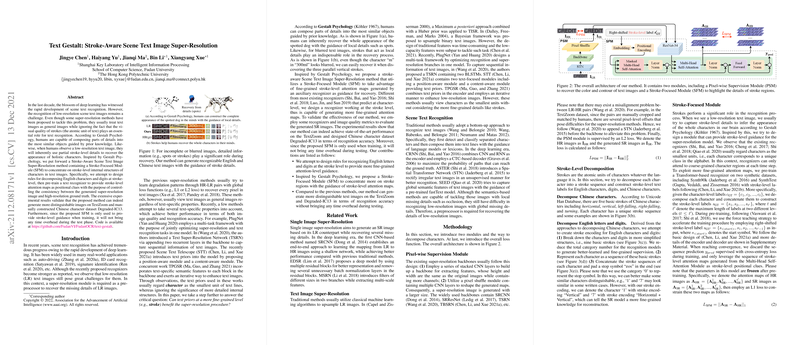Analysis of "Text Gestalt: Stroke-Aware Scene Text Image Super-Resolution"
The paper "Text Gestalt: Stroke-Aware Scene Text Image Super-Resolution" introduces a novel approach to enhancing low-resolution scene text images by incorporating stroke-level details. This research extends traditional super-resolution methods by leveraging insights from Gestalt Psychology, emphasizing the importance of stroke details in text images.
Core Contribution
The authors propose a Stroke-Aware Scene Text Image Super-Resolution method that focuses on enhancing the visual quality of stroke details, using a Stroke-Focused Module (SFM). Unlike conventional methods that treat text images as general images, the SFM emphasizes stroke-level internal structures, providing finer granularity by decomposing characters and digits at the stroke level.
Methodology
The proposed methodology consists of two main components:
- Pixel-wise Supervision Module (PSM): This module is based on traditional CNN-based architectures and is responsible for color and contour recovery in low-resolution images. It uses standard L2 loss to supervise the super-resolution task.
- Stroke-Focused Module (SFM): The SFM directs attention to stroke regions, guiding the recovery process with stroke-level attention maps generated by an auxiliary recognizer pre-trained on synthetic datasets. The use of stroke-level attention maps, rather than character-level, provides more fine-grained guidance.
Experimental Validation
The research demonstrates the efficacy of the proposed approach through experiments on TextZoom and a specially constructed Chinese character dataset, Degraded-IC13. The results highlight significant improvements in recognition accuracy, underscoring the model’s capability to produce more distinguishable images. The paper reports a notable enhancement of up to 7.5% in recognition accuracy on challenging subsets of TextZoom.
Theoretical and Practical Implications
Theoretically, this research emphasizes the importance of employing fine-grained units such as strokes in image reconstruction tasks, challenging the commonplace reliance on character-level approaches. Practically, this method provides a robust preprocessing step for applications in environments where low-resolution text images are prevalent.
Future Directions
Future research could explore extending the stroke-level approach to other character-based languages and evaluating efficacy in more diverse scenes. Additionally, integrating this approach with semantically-aware models could yield further improvements in contexts requiring linguistic context understanding.
Conclusion
This paper effectively addresses the persistent challenge of low-resolution text image recognition by deploying a stroke-aware approach. The utilization of Gestalt principles to focus on stroke-level detail represents a meaningful advancement in the field of scene text recognition. The insights provided here pave the way for more nuanced and effective super-resolution techniques in AI.
